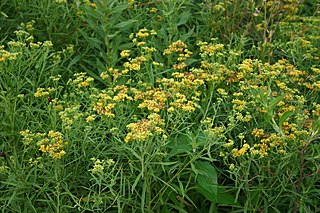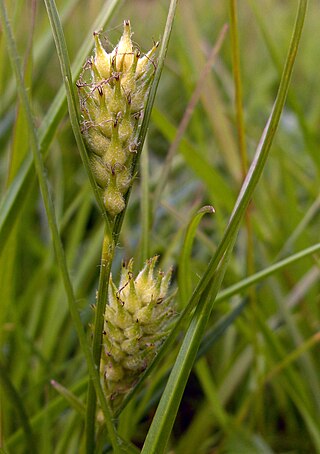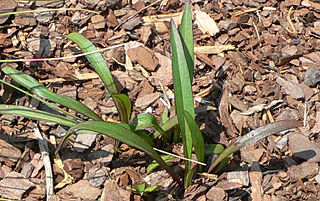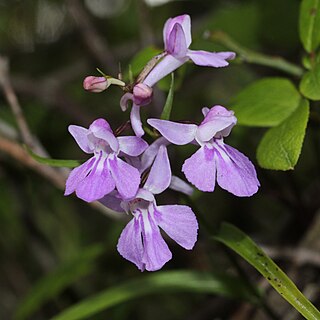
Ornamental grasses are grasses grown as ornamental plants. Ornamental grasses are popular in many colder hardiness zones for their resilience to cold temperatures and aesthetic value throughout fall and winter seasons.

Arundina graminifolia is a species of orchid and the sole accepted species of the genus Arundina. This tropical Asiatic genus extends from Myanmar, India, Sri Lanka, Nepal, Thailand, Vietnam, the Ryukyu Islands, Malaysia, Singapore, China to Indonesia, the Philippines and New Guinea. It has become naturalized in Réunion, Fiji, French Polynesia, Micronesia, the West Indies, Costa Rica, Panama, Belize, and Hawaii. It is also called bamboo orchid.

Carex is a vast genus of nearly 2,000 species of grass-like plants in the family Cyperaceae, commonly known as sedges. Other members of the family Cyperaceae are also called sedges, however those of genus Carex may be called true sedges, and it is the most species-rich genus in the family. The study of Carex is known as caricology.
Werneria graminifolia is a species of flowering plant in the family Asteraceae. It is found only in Ecuador. Its natural habitat is subtropical or tropical high-altitude grassland. It is threatened by habitat loss.

Euthamia graminifolia, the grass-leaved goldenrod or flat-top goldentop, is a North American species of plants in the family Asteraceae.

Utricularia graminifolia is a small perennial carnivorous plant that belongs to the genus Utricularia. It is native to Asia, where it can be found in Burma, China, India, Sri Lanka, and Thailand. U. graminifolia grows as a terrestrial or affixed subaquatic plant in wet soils or in marshes, usually at lower altitudes but ascending to 1,500 m (4,921 ft) in Burma. It was originally described and published by Martin Vahl in 1804. It has also recently been grown in planted aquaria. It is however not a true aquatic species, as seen in species from Utricularia subg. Utricularia.

Isoetopsis is a genus of Australian flowering plants in the daisy family.

Cape Flats Sand Fynbos (CFSF), previously known as Sand Plain Fynbos, is a critically endangered vegetation type that occurs only within the city of Cape Town. Less than 1% of this unique lowland fynbos vegetation is conserved.

Lespedeza leptostachya is a rare species of flowering plant in the legume family known by the common names prairie lespedeza and prairie bush-clover. It occurs in the Upper Midwest region of the United States. The flowers are creamy-white to purplish and arranged into a narrow terminal spikes.

Carex riparia, the greater pond sedge, is a species of sedge found across Europe and Asia. It grows in a variety of wet habitats, and can be a dominant species in some swamps. It is Britain's largest Carex, growing up to 130 cm tall, with glaucous leaves up to 160 cm long. It hybridises with a number of other Carex species, including the closely related Carex acutiformis – the lesser pond sedge. A variegated cultivar is grown as an ornamental grass.

Carex hirta, the hairy sedge or hammer sedge, is a species of sedge native across Europe. It has characteristic hairy leaves and inflorescences, and is the type species of the genus Carex.

Pityopsis graminifolia is a species of flowering plant in the family Asteraceae known by the common names grass-leaved golden-aster and narrowleaf silkgrass. It is native to the southeastern United States, occurring as far north as Ohio and Maryland.

Carex sect. Ovales is a section of the genus Carex, containing around 85 species of sedge. It is the most diverse section of the genus in North America, containing 72 species:

Carex subg. Carex is a subgenus of the sedge genus Carex. It is the largest of the four traditionally recognised subgenera, containing around 1400 of the 2000 species in the genus. Its members are characterised by the presence of one or more exclusively male (staminate) terminal spikes, quite dissimilar in appearance from the lateral female (pistillate) spikes below. In most species, the female flowers have three stigmas, but a few species, including Carex nigra, have female flowers with only two stigmas.

Carex subg. Vignea is a subgenus of the sedge genus Carex, containing around 300 of the 2000 species in the genus. Its members are characterised by having bisexual, sessile spikes, where the female flowers have two stigmas each.

Disa graminifolia is a species of orchid found in the Cape Floristic Region of South Africa.

Marshallia graminifolia is a perennial herb species, endemic to the coastal plains of the Southern United States, where it often grows in bogs and in sunny locations. Like all species in the genus Marshallia, it has the common name Barbara's buttons, and is specifically known as grassleaf Barbara's buttons.

Ponerorchis graminifolia is a species of flowering plant in the family Orchidaceae, native to southern Korea and Japan. They are short herbaceous perennials, growing from a tuber, with small flowers in shades of pink to purple. Many varieties and cultivars are grown in Japan as ornamental plants. The Japanese name for the species is transcribed as uchou-ran or utyouran.















